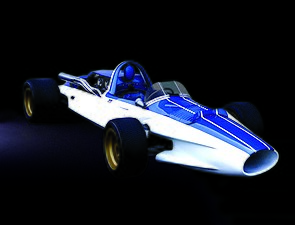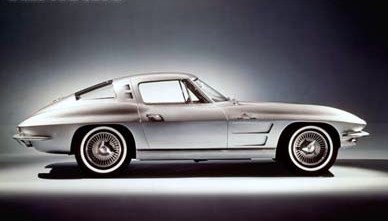Larry Shinoda
Larry Shinoda | |
|---|---|
 | |
| Born | Kiyoshi Lawrence Shinoda[1] March 25, 1930 Los Angeles, California |
| Died | November 13, 1997 (aged 67) |
| Occupation | automotive designer |
| Years active | 1955–97 |
| Notable work | Chevrolet Corvette (C2), Chevrolet Corvette (C3), Boss 302 Mustang |
Lawrence Kiyoshi (Larry) Shinoda (March 25, 1930 – November 13, 1997) was a noted American automotive designer who was best known for his work on the Chevrolet Corvette and Ford Mustang.
Early life and internment
He was born in
Shinoda grew up in
At camp, he snuck past the barbed wire to play and fish. His first recorded functional design was a set of reclining back chairs for his mother and grandmother at the incarceration camp that attracted the admiration of other incarcerees.[6] The family was released and moved to Grand Junction, Colorado in spring 1944 to help out at a farm owned by his paternal grandfather; that side of the family had avoided incarceration by fleeing California.[3]
Shinoda completed his high school education at
Career
As a young man in Los Angeles, he built hot rods and raced them on the streets.[4] One of the first cars he built was "Chopsticks Special", a 1932 Ford deuce coupe equipped with a 298 flathead V8, which he acquired from a coworker at Weiand, Bob Lee. Shinoda sold the Deuce coupe in 1953 to Don Montgomery and built a 1929 Ford roadster;[10] the coupe has since been identified and restored.[11] His '29 Ford, named "Chopsticks Special IV", was powered by a flathead V8 with Ardun OHV heads.[9] Shinoda won the "A" Hot Roadster class at the first NHRA U.S. Nationals held in Great Bend, Kansas with Chopsticks Special IV in 1955.[4][12][13] Shinoda sold the '29 Ford as parts to his partner in the car, Jack Powers, in 1956.[9]
General Motors
"[Mitchell] had a Pontiac with a supercharger on it, and he had been driving home from work one evening. At the time, I had this white '55 Ford that had a 352 Ford stock car racing engine in it that had been shipped to me by Bill Stropp. I installed the engine in it, along with all the other goodies, and I basically had a street-driven NASCAR stock car. Well, I pulled up next to Mitchell at a red light one evening, the light changed and Bill took off, smoking the tires. I waited until he hit second gear, and then I passed him in first. He turned off at the next light. Then he came into the Chevy studio and he's telling McKeegen, the boss, about this white Ford that blew his doors off; he said he thought it must have had a Cadillac engine in it. And McKeegen says, 'Hey, Larry - you have a white Ford, don't you?' and I answered, 'Yeah'. Mitchell wanted to see my car, so I brought it into the garage, and when I popped the hood open he just about had a heart attack."
Larry Shinoda, Vette magazine interview (1997)[14]
Shinoda met Ford vice president
Initially, Shinoda was assigned a six-month orientation class after being hired at GM, but was pulled early and assigned to the Chevrolet studio after one of his designs attracted attention; there he was credited with designing sharper fins, including the manufacturing process, for the
Ford
"One of the first things I did on coming to Ford was straighten out the Boss 302. They were going to call it the SR2. They had all this chrome on it. They were going to hang big cladding on the side, big rocker moldings. It was going to be more garish than the Mach 1. They had a big grille across the back and a great big gas cap and fake cast exhaust outlets and big hood pins and a really big side scoop. I took all that off, went to the C-stripe decal and painted out the hood, did the rear spoiler and the window shades and front airdam."
Larry Shinoda, Consumer Guide interview[16]
In 1968
Freelance
After leaving Ford, Shinoda and Knudsen co-founded
While working for Rectrans, Shinoda designed the "American Dragster" slingshot streamliner dragster.[19]: 40 This car had a fully enclosed wedge-shaped body, with only the front wheels, fitted with lakester-style wheel discs (Moon discs), exposed.[19]: 40 Little is known about the project; it is likely interest was sparked by Shinoda's pre- and post-WW2 experience racing roadsters in the Los Angeles area.[19]: 40
Shinoda later opened an independent design firm and did work for GM, Ford, and aftermarket companies. In 1985, he was competing with an
Shinoda developed kidney problems starting in 1996, yet continued to be an active designer.[6] Before a transplant surgery could take place, he died of heart failure on November 13, 1997 at his home in Bloomfield Hills, Michigan, aged 67.[4] His daughter, Karen, formed Team Shinoda (now Shinoda Performance Vehicles), a tuner and performance parts company.[24]
Designs
Notable designs by Larry Shinoda:[25][26]
- 1959 Stingray Racer (XP-87, with Pete Brock and Bill Mitchell)
- 1960 CERV I
- 1962 Corvair Super Spyder (XP-785)
- 1962 Monza GT (XP-777)
- 1963 Monza SS (XP-797)
- 1963 Mako Shark I (XP-755)
- 1963–67 Chevrolet Corvette (C2)
- 1964 CERV II
- 1965 Mako Shark II (XP-830)
- 1965 Chaparral 2C
- 1967/68 Chevrolet Astro I (XP-842), II (XP-880)
- 1968–82 Chevrolet Corvette (C3)
- 1969/70 Boss 302 Mustang
- 1970 Ford Torino King Cobra
- 1990 Rick Mears Special Edition Corvette[27]
- 1993 Jeep Grand Cherokee (ZJ)
- National Corvette Museum logo
- Notable designs by Larry Shinoda
-
John Zink
-
1960 CERV I concept
-
1962Corvair Monza GTconcept
-
1963 Mako Shark I concept
-
1963 Corvette Sting Ray Coupe
-
1964 CERV II concept
-
1965 Mako Shark II concept
-
1968 Corvette Sting Ray Convertible
-
1969 Boss 302 Mustang
References
- ^ a b "Display Full Record: Individual no. 20983G | Shinoda, Kiyoshi L". Japanese-American Internee Data File. The National Archives. 1946. Retrieved 11 February 2022.
- ^ "Display Full Record: Individual no. 20983E | Shinoda, Hide". Japanese-American Internee Data File. The National Archives. 1946. Retrieved 11 February 2022.
- ^ a b "Manzanar ID Card: Grace Aiko Shinoda; Family # 20983; Camp: Manzanar, CA". National Park Service.
- ^ a b c d Koveleski, Oscar. "The Designer". Pasadena City College. Archived from the original on 12 February 2011. Retrieved 16 November 2010.
- ^ According to the Japanese-American Internee Data File, the Watanabe family interned at Manzanar also includes Aiko, born 1909 (20983A); Toshihisa, born 1911 (20983B); Teru, born 1914 (20983C); and Masano, born 1882 (20983D).
- ^ a b c "Larry Shinoda - 1998 Induction to the Corvette Hall of Fame". National Corvette Museum. Retrieved 16 November 2010.
- ^ a b "Manzanar ID Card: Lawrence Kiyoshi Shinoda; Family # 20983; Camp: Manzanar, CA". National Park Service.
- ^ a b c d e Teeters, K. Scott (February 16, 2018). "Corvette's Founding Fathers Pt 5: Designer Larry Shinoda". Motor Trend. Retrieved 8 February 2022.
- ^ a b c d Larry Shinoda (1995). "The Designer's Story: Larry Shinoda". Corvette Action Center (Interview). Interviewed by Wayne Ellwood. Retrieved 11 February 2022.
- ^ "Larry Shinoda's 1932 Ford". Kustomrama. Retrieved 11 February 2022.
- ^ Strohl, Daniel (August 2011). "1932 Ford Three-window Coupe". Hemmings Motor News. Retrieved 11 February 2022.
- ^ a b c Strohl, Daniel (April 2010). "Larry Shinoda". Hemmings.
- ^ Burgess, Phil (27 October 2021). "Reliving NHRA's first race: the 1955 National Championship Drags in Great Bend". NHRA. Retrieved 11 February 2022.
- ^ a b Larry Shinoda (December 1997). "The Studio X Years". Vette (Interview). Interviewed by Tom Benford. Archived from the original on May 28, 2013.
- ISBN 9780429423918. Retrieved 29 November 2023.
- ^ "Larry Shinoda: Creator of the Ford Mustang Boss 302". How Stuff Works. Archived from the original on March 20, 2007.
- ^ Heasley, Jerry (June 15, 2015). "Larry Shinoda's First 1969 Boss 302 Mustang Concept Car: Most Amazing Barn Find Ever?". Motor Trend. Retrieved 8 February 2022.
- ^ a b "Ex-Ford Head Forms New Firm". The Courier-Journal. Louisville, Kentucky. AP. November 1, 1970. Retrieved 10 February 2022.
- ^ a b c d Taylor, Thom (April 2017). "Beauty Beyond the Twilight Zone". Hot Rod. pp. 30–43.
- ^ "Knudsen Brings New Shape To the Motor Home Market". Detroit Free Press. November 11, 1970. Retrieved 10 February 2022.
- ^ "Larry Shinoda Design: 1973 Rectrans Discoverer RV". Bring a Trailer. August 13, 2015. Retrieved 10 February 2022.
- ^ Whittaker, Jeanne (August 26, 1971). "Bunkie Makes His 'Debut' in Cleveland". Detroit Free Press. Retrieved 10 February 2022.
- ^ a b Rothenberg, Al (1 March 1998). "Design Debate - Who's the father of the Jeep Grand Cherokee". Ward's AutoWorld. Archived from the original on 2 December 2010. Retrieved 16 November 2010.
- ^ "About Us". Team Shinoda. Archived from the original on 2011-07-16. Retrieved 16 November 2010.
- ^ Burton, Jerry (26 February 2018). "Larry Shinoda: Looking back at a legend". Hagerty Media. Retrieved 10 February 2022.
- ^ McAleer, Brendan (28 March 2019). "Know your designers: Larry Shinoda". Hagerty Media. Retrieved 10 February 2022.
- ^ Larry Shinoda (1995). "Rick Mears Corvette" (Interview). Interviewed by Wayne Ellwood. Corvette Action Center. Retrieved 10 February 2022.
External links
- Development of the Sting Ray
- Ellwood, Wayne (1995) Interview with Larry Shinoda
- Ellwood, Wayne (1995) Mako Shark Interview with Larry Shinoda
- Ellwood, Wayne (1995) XP-819 Interview with Larry Shinoda
- Larry Shinoda at the GM Heritage Center
- Larry Shinoda at the National Corvette Museum Hall of Fame
- Larry Shinoda at the Mustang Club of America Hall of Fame
- Larry Shinoda at the Pasadena City College alumni history site
- Team Shinoda, a company co-founded by daughter Karen and named in his honor










